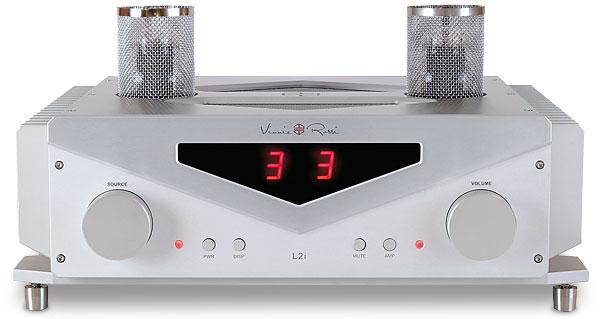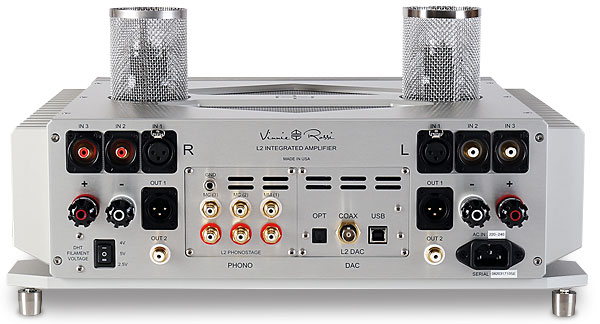Vinnie Rossi L2i-SE Integrated Amp/DAC

 Can't choose between tubes and transistors? Vinnie Rossi may have the answer with the L2i-SE integrated amplifier, which deals with that conundrum in a unique manner
Can't choose between tubes and transistors? Vinnie Rossi may have the answer with the L2i-SE integrated amplifier, which deals with that conundrum in a unique manner
So overwhelming is the matter of choice when putting together a system that it can cause as much anguish as pose a fun challenge. What type of speakers? MM or MC pick-up? Integrated or separates? These usually sort themselves out due to space or budget, but 'tubes versus transistors' almost calls for a leap of faith – unlike 'digital versus analogue' because most enthusiasts can manage two sources. The valve/solid-state conflict, though, may find a cure in the Vinnie Rossi L2i-SE integrated amplifier, the 'SE' standing for 'Signature Edition'.
Until this came along, addressing the matter usually involved either a hybrid product, eg, Radford's pioneering TT100 with solid-state input and tube output, or pairing a valve preamp and transistor power amp (or less often, a solid-state preamp and tube power amp). Vinnie Rossi's one-box solution may not be cheap at £18,995 in line-level form, or £25,985 with phono stage and DAC, but it is so clever and truly fascinating on an intellectual level that its absolute performance may even be secondary. I know that is near-heresy, but hear me out.
Glass Tiger
Simply stated, this can be used as a strictly solid-state integrated amplifier or with a valve 'element' that can be switched in. My initial reaction was to recall Musical Fidelity's X-10D 'tube buffer' of 25 years ago, which injected euphonic tube colour into one's system. I loved it, but then I have my own peculiarities. The X-10D, though, was fun, inexpensive and thus a godsend for impoverished hobbyists.

Vinnie Rossi's concept is more complex, but also difficult to assess because switching from solid-state to 'plus valves' nearly triples the gain, as well as applying the tube traits, so one needs to be careful when comparing the two. Swapping between them is fiddly, so A/B comparisons are not possible unless you have two units and some form of comparator to switch between them. The swap requires the removal of the two 300Bs, flicking the internal 'DHT' (Direct Heated Triode) toggles next to each valve base, refitting the tubes and then switching the amplifier back on. And there's also a warm-up pause to add to the delay.
I asked company owner Vinnie why he made it such a lengthy procedure, instead of fitting a front panel selector with level compensator. He explained, 'The unit needs to be powered off when you flip those switches, otherwise you'll get a big pop from your speakers. I actually never intended that switch to be used often. It's more like a tool to evaluate what the triodes are adding to the sonic landscape – so you can hear what you have been missing without them'.
Fully Loaded
It's easy to see his logic, for unlike the front-panel facility for bypassing the power amp for use as just a preamp, which might be used frequently but threatens no risks, I suspect that users will prefer one mode over the other and leave it that way. I spent several days with the unit in solid-state mode, but after injecting the tubes, I never went back. Long-term readers have already surmised that I would prefer to have the triodes in circuit, given my known passion for glassware. No surprises there, then.
Even for those who acquire the L2i-SE because of tube-vs-tranny indecision, it is still unlikely that switching between them will be a regular occurrence. If this raises the question of it being too elaborate a feature if it's only to be used rarely, I prefer to look at it this way: the mere option of being able to choose between valves and solid-state alone is precisely the reassurance one needs if one genuinely is unable to make a permanent decision.

Now that you know the L2i-SE's main party trick, let's not let this aspect of the design overshadow the rest of what is on offer, especially in fully 'loaded' form. I loved having three phono inputs – one MM and two MC, with adjustable gain – and the ability to alter the load via remote, a must-have when assessing new cartridges. The DAC module also accepts three sources, and the remote allows you to play with the digital filters and invert phase from the hot seat. As for line sources, the L2i-SE handles two single-ended and one XLR balanced. Then there's the preamp output option.
That is self-explanatory, and worth having if you're the sort who wants to dig out an old amp that's lying around, or to upgrade the amp section sometime in the future. But it also serves another purpose, which I learned of when I asked Vinnie why there was no headphone output in this day and age of headphone dominance (and of late the increase in headphone usage during lockdown to prevent domestic warfare).
Vinnie said, 'Adding a headphone jack to the front panel did not visually appeal to me, especially the balanced, 4-pin XLR jack that most people want with the higher performance headphone models. However, there is a "secret" with the L2i-SE: with the use of an adapter cable, one can connect to the balanced XLR output jacks and convert it to a 4-pin XLR, and it drives most headphones with ease. You simply press the 'AMP' button on the front panel to turn off the speaker outputs. We do not sell the adapter cable, but Moon Audio in the USA has been making them for our customers'.
With that out of the way, I found nothing else to question. I even got a kick out of the company name, which sounds like a gunsel for Tony Soprano. The L2i-SE worked faultlessly, the quality of the construction and components was first class, especially the multi-way speaker terminals, the display was informative and I loved every second I spent with it. But to get to the heart of this, we must first address solid-state-only versus the 300Bs in operation.
![]() Totally Hooked
Totally Hooked
Because the amp was in solid-state mode when it arrived from Editor PM, I tried that first. Here I must make a confession for I knew in my heart-of-hearts that my deep-rooted prejudices would have me preferring the triode mode, that I would switch to it after my time with the solid-state listening and thus would not have to go back and forth. However, what I wasn't anticipating was that I would actually be charmed by the solid-state-only session.

























































